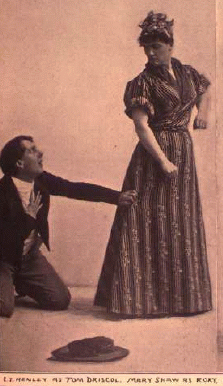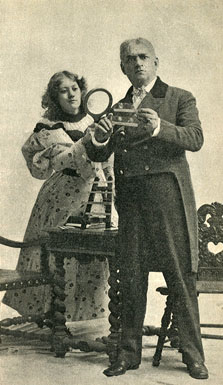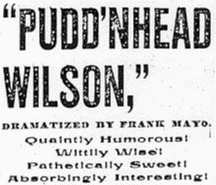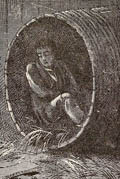
So reads the titlepage of the only script of Pudd'nhead Wilson that I have found. This typescript was the property of the American Play Company, Inc., of New York City, and is undated, though according to the copyright claim it must have been prepared in or after 1909. Mayo died in 1896, while on tour with the play. There's no way to know how the script may have been revised afterwards, but it's likely that the text you can read here is essentially the version of the play that hundreds of thousands of Americans saw during the 1890s.
Mayo's script clearly seeks to stay close to MT's novel, while adapting it to the demands of production and the expectations of play-goers. Several of Pudd'nhead's calendar epigrams, for example, are interpolated into his dialogues. Mayo tightens the narrative by making Patsy and Rowena Wilson's relatives, keeping the action (with the exception of a scene at a "ruined mill," the play's version of the novel's haunted house) in Wilson's yard and office. Rowy, as Rowena is called here, has a much larger part: since, as an announcement in The New York Times put it, "the novel lacks a love story, without which no drama is complete, Mr. Mayo has supplied this deficiency by introducing a sentimental element." But (as one might predict from Mayo's star status) the story centers on Wilson himself. Much of the play's dramatic momentum derives from watching "Pudd'nhead" struggle to overcome his demeaning nickname. According to the reviews, his ultimate forensic triumph and public vindication was the point of the story: while merit is often unrecognized, ultimately it will be rewarded.

The script allows us to appreciate the way the play emphasized the "Southern" flavor of the story, from the soundtrack consisting of "Lively Southern music" sung by a "Colored quartette" to the attempt to represent southern accents in the dialogue (the play's first word is "hya'r"). During the Nineties plays with ante bellum southern settings were very popular with audiences around the country. Mayo's representation of that culture is ambiguous. On the one hand, the sympathetic characters often overtly express contempt for how "benighted" the local populace is, and the play treats the selling of slaves "down the river" and the miscegenous conduct of white slave owners more directly that MT's text does. (Mayo makes Roxy's child the son of York Driscoll, which both tightens the dramatis personae and puts the interracial relationship between a male master and his female slave right in front of an audience's eyes.) But at the same time, the institution of slavery is largely idealized: at various points the slaves say things like "God bless you, Marse York."
One of Mayo's most striking changes is to make the switching of the "white" and "black" babies happen as a mistake, made by Aunt Patsy. Roxy is the only one who recognizes the error. The stage directions say explicitly that she never thought of making the switch herself, but in her response to the event, which gives the Prologue its curtain lines, something of the novel's depiction of the exchange as her revolt against an unjust system can still be heard -- though only in passing, as it were. Mayo's depiction of the impostors "Tom" and "Chambers" seems mainly calculated to reassure viewers that "blood," like merit, will always eventually tell, that the innate differences between "white" and "black" explain the nobility displayed by "Chambers" and the viciousness of "Tom." But here again, the play is complex and ambiguous. "Chambers" plays a much larger role in the play too, as Rowy's closest friend, surrogate brother, protector -- and at times, almost, suitor. Act 2, Scene 2 includes an ideologically disruptive moment when "Chambers," as a "black slave," defends Rowy from the insults of a "white gentleman," physically assaulting the "white" man in the process. Some southern reviewers objected to the part "Chambers" plays, especially with Rowy, but one New York reviewer declared the play would be stronger if "Chambers"'s "human nature" as someone "by birth white and aristocratic" asserted itself and he "boldly declare[d] his passion for Roxy." In the script both Rowy and "Chambers" angrily reject the idea that their relationship has any romantic content, and they don't come together as hero and heroine of the love story until after Pudd'nhead establishes the changeling's true identities. While the audience knows all along that "Chambers" is really the white Tom, Rowy doesn't. Yet how most viewers reacted to the moments in which the play verges on becoming a love story between a black man and a white woman remains unknown.

